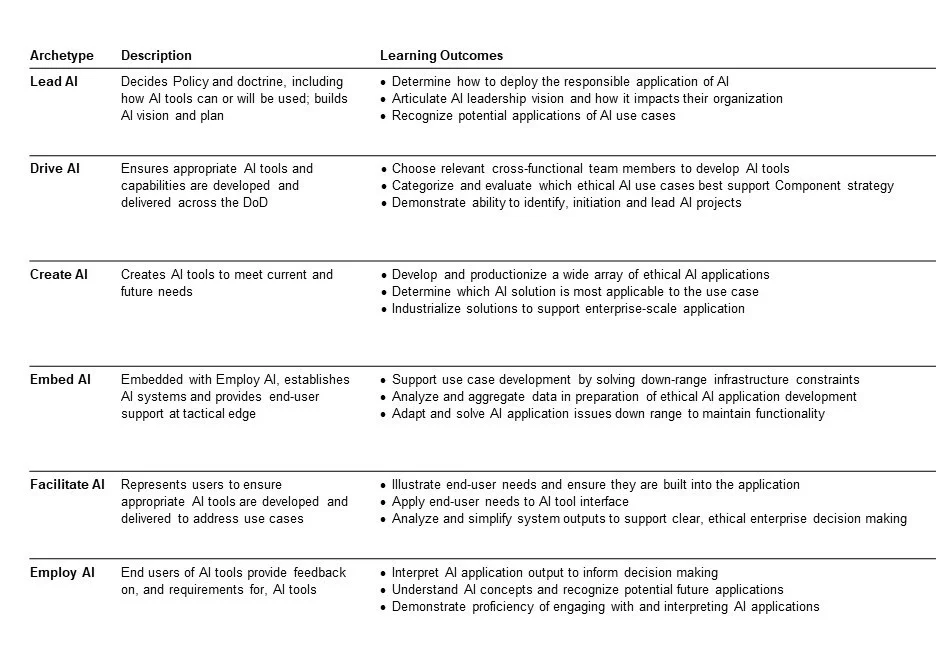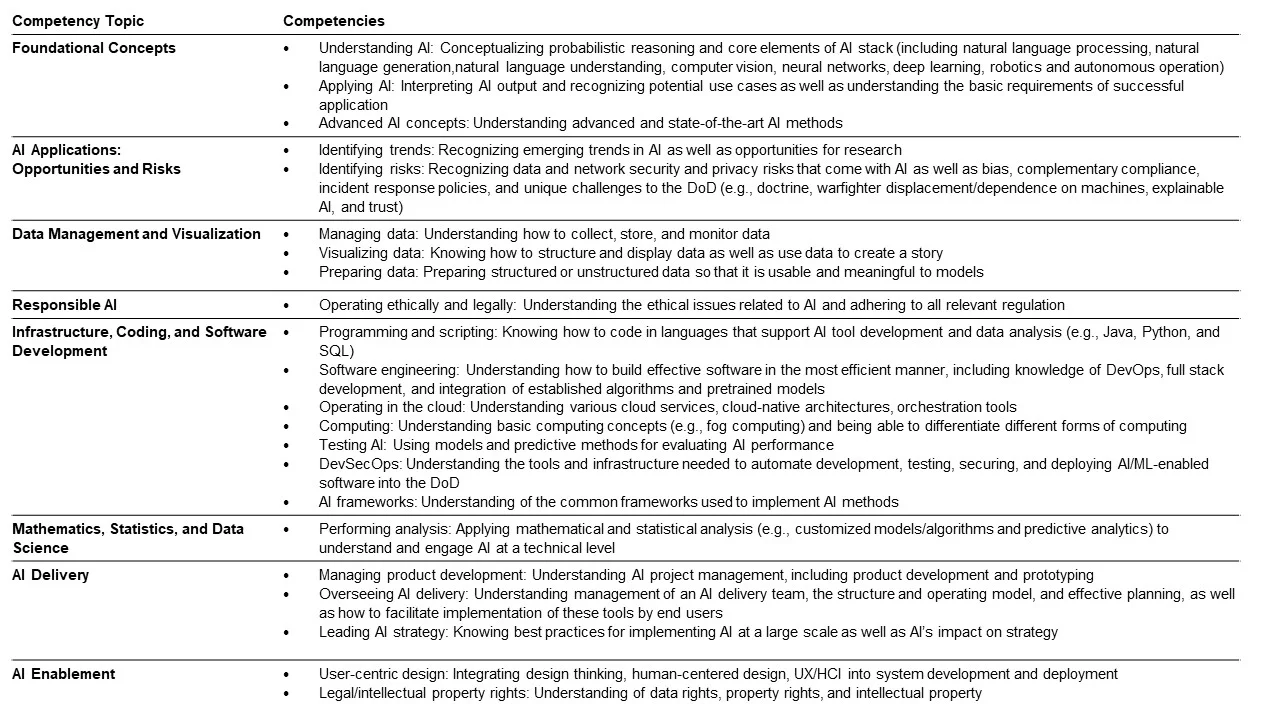How to Grow an AI-Ready DoD Workforce
Investment in artificial intelligence (AI) capabilities enables organizations to improve strategic decision-making and business processes to stay competitive. The World Economic Forum estimates that by 2025 there will be 97 million AI and AI-related jobs created globally, which will contribute $15 trillion to the global GDP. Like the private sector, the Department of Defense (DoD) also recognizes the need to invest in AI research and development. Doing so increases our technological and operational edge over our adversaries. To ensure superiority on future battlefields, the DoD is investing $847 million in FY22 to support AI and AI-related projects, including more than 600 projects already in progress. Over the next five years, DoD investments in DARPA-related AI research projects are expected to exceed $1.5 billion.
These investments necessitate the rapid expansion of a technology-literate workforce to create, sustain, and implement AI capabilities. The global workforce shortage has accelerated, however, even as the demand for AI and AI-related skills has increased. Critical to the AI capabilities developed, delivered, and employed at scale are the people who will ultimately be making decisions informed by AI. Section 256 of the National Defense Authorization Act of 2020 and the National Artificial Intelligence Research and Development Plan establish a U.S policy to prioritize building an AI-capable workforce. These workforce development policies emphasize an AI education strategy for the DoD as an important step in ensuring that the military can win future conflicts against peer competitors.
An AI-ready workforce is essential to building, adopting, and deploying AI capabilities. Moreover, this workforce must include both technical and non-technical skillsets across all grades and ranks. This post discusses the unique challenges of AI engineering for defense and national security, how to build an AI-ready workforce, and how the SEI is supporting DoD workforce development needs.
Current AI Challenges for the DoD
Increasing the AI talent pipeline by training more people in ways that complement the DoD AI Strategy could help reduce the skills gap the DoD faces. The DoD is working to better understand what AI talent is needed, the current state of its AI talent, and how to prioritize and pursue AI workforce development. New efforts are underway to formalize processes and develop systems for identifying who possesses what skills and how to match those skills to needs within the service branches.
For example, the U.S. Army is developing a system to track soldiers’ specialized skills, goals, and aspirations. Likewise, the U.S. Navy is developing the Sailor 2025 program to modernize its personnel management system. Moreover, the U.S. Air Force and Marine Corps are developing an HR marketplace to identify talent. Each service is creating its own talent tracking system, however, so standardizing roles and competencies is hard.
The DoD also faces the challenge of increased competition for talent as the demand for AI workers increases across all sectors. However, DoD requirements for security clearances and citizenship—and potentially lower salaries compared to the private sector—make the DoD less competitive in the labor marketplace. In light of these challenges, we see three opportunities to support the DoD in developing and sustaining an AI-ready workforce:
- standards and frameworks
- archetypes that accelerate the adoption and built trust of AI systems
- training and certifications that open the AI talent pipeline
Develop Standards and Frameworks
The cybersecurity ecosystem has developed standards, such as the NIST 800-181—NICE framework that standardizes knowledge, skills, abilities (KSAs), work roles, and competencies. In contrast, the AI ecosystem has not yet developed such a framework. However, the Chief Digital and AI Office (CDAO, formerly JAIC) developed the 2020 Department of Defense AI Education Strategy, which addresses grouping personnel into similar AI work roles and the competencies needed to perform those roles. This strategy includes priorities of four key areas that will support the AI Education Strategy’s priority of delivering AI capabilities at scale:
- Prioritize AI awareness for senior leaders.
- Create a cadre of integrated project teams to deliver AI capabilities.
- Create a common foundation for DOD’s digital workforce.
- Certify and track AI talent.
The DoD AI Education Strategy includes six archetypes that outline a set of technical and nontechnical roles, each with overall learning outcomes (see Figure 1). These archetypes describe the roles and skillsets needed to accelerate AI adoption at the technical and nontechnical levels. The archetype roles are associated with 22 KSAs spanning eight topic areas requiring beginner, intermediate, or advanced level proficiencies (see Figure 2). Topic areas range from foundational concepts that build an understanding of AI and the application of AI systems to AI enablement concepts that focus on human-centered design of AI systems. The KSAs in each topic area are part of the recommended curriculum for each role within each archetype.


The roles and competencies outlined in the AI education strategy provide a high-level learning journey to guide the training and development of the DoD AI workforce. This strategy provides an opportunity for the AI engineering community to define a common lexicon and build frameworks that enable teams to work across disciplinary boundaries as they develop and deploy AI capabilities. Likewise, this strategy will allow employers to benefit from workforce frameworks as they try to standardize hiring, define roles, and specify the type of work needed in their organizations.
In addition, education and training providers can develop curricula, learning outcomes, certification, and verification processes in a consistent manner. Learners can increase competencies and learn about career paths in AI. Overall, the AI engineering discipline can draw on frameworks centered on the workforce to develop and adhere to rigorous standards for engineered systems and ensure compliance to regulatory requirements. Frameworks and standards also guide practitioners on achieving certifications, developing and maintaining proficiencies, and contributing to the body of knowledge.
Focus on Archetypes that Accelerate the Adoption and Built Trust of AI Systems
Driving organizational adoption of AI, integrating AI into warfighting capabilities, and developing AI policies all require leadership support. Workforce development efforts must prioritize curriculum for the “Lead AI” archetype to provide policy makers and senior leadership the ability to make informed decisions on the use of AI-enabled technology to enhance mission success. As noted in the DoD AI Strategy, building policy-level coursework that focuses on how the DoD will responsibly use and employ AI, how AI adoption enables broader vision and impact for the organization, and understand the potential applications of AI will help accelerate adoption and create an AI ecosystem.
In our experience, transformation initiatives that include only leadership have a high probability of failure. It is therefore critical to employ a multi-pronged strategy that includes end users of AI capabilities (Employ AI), as well as middle managers (Drive AI). The users in the Employ AI role (the largest of all archetypes) focus on the how AI tools can increase job performance and mission success.
For example, soldiers at the tactical edge—individuals who use AI-enabled systems that identify threats on the battlefield—need to understand how data collection and curation affect the outcomes of the object detectors used in the system. Intelligence analysts working on cognitive electronic warfare (EW) systems, which use AI algorithms to reconstruct missing data from radar sources, need to understand how data structure affects system accuracy and robustness. As the DoD works to implement strategies and programs to grow the AI workforce, it needs to remain focused on the unique needs and potential contributions of each archetype.
Build Training and Certifications that Open the AI Talent Pipeline
Skills shortages caused by positions requiring a high degree of training, advanced degrees, or many years of experience slow the AI talent pipeline. A 2020 survey found that 39 percent of the 1,000 executives surveyed chose not to adopt AI due to lack of expertise in their organizations. Of the six archetypes, only Create AI and Embed AI require some advanced levels of training and, in some cases, an advanced degree. Attaining these credentials can take many years, depending on the level of mastery needed.
For the remaining archetypes, many competencies and required KSAs can be achieved through experiential learning methods, and the need to understand state-of-the-art AI research methods and theory (topics usually reserved for academic settings) may be unnecessary. An AI trade school would be able to accomplish the required education and training for many of these applied competencies. For instance, soldiers in the field may need to know how to pull raw imagery data off robots, curate the data, and prepare it so that new machine learning (ML) models can be retrained. The intelligence analyst using an AI-enabled capability to reconstruct missing EW data may need to understand how that system is calculating the data and what parameters can be tuned to increase accuracy. A trade school environment can be used to teach the foundational and applied topics that provide leaders with the tools they need to understand how these, and other AI capabilities can be integrated into the mission ethically and responsibly.
A certification process can also be developed to validate and certify the attainment of a baseline knowledge proficiency acquired in an AI trade school. For instance, to validate the KSAs of its cybersecurity workforce, the DoD developed the DoD Directive 8570. This directive lists the approved industry-level certifications that the workforce must attain, depending on job category. In the future, a similar directive (along with AI and AI engineering certifications that satisfy the competencies outlined in the DoD AI Education Strategy) could be developed and used to certify the defined archetypes.
SEI-Tailored AI Training
To support the DoD as it builds and develops its AI-ready workforce, the SEI offers tailored training that supports the adoption, creation, and employment of AI capabilities at scale and at mission speed. Our current offerings approach the use of AI from an engineering perspective and equip
- commanders and executives (Lead AI) with the skills needed to assess and frame where AI connects to their current problem landscape
- AI practitioners representing all archetypes to understand and implement AI ethics and responsible AI
- data technicians (Employ AI) with the skillsets and mindsets needed to develop AI literacy, triage systems, assess data pipelines and engage in the implementation of AI capabilities
As the SEI grows our suite of training opportunities, one of our near-term focus areas is responsible AI, a priority the DoD identifies as key to trust. Over the next year, the SEI will add courses and workshops that cover topics focusing on the deployment and responsible application of AI, how AI capabilities will impact organizations, oversight of AI-enabled systems, leading practices for human-machine interaction, and engaging with and interpreting AI applications.
Is there an AI topic your organization is interested in learning about? Contact the team to let us know.
Additional Resources
Be sure to check our AI workforce development project page on the SEI Website for more information, including podcasts and courses that your organization can benefit from.
In a recent podcast on AI Workforce Development, Rachel Dzombak and Jay Palat discuss how organizations can hire and train staff to take advantage of the opportunities afforded by AI and machine learning—and the critical need for an AI engineering discipline to grow the AI workforce.
In the blog post 5 Ways to Start Growing an AI-Ready Workforce, Rachel Dzombak and Jay Palat outline 5 factors that are critical for organizations and leaders to consider as they grow an AI-ready workforce.
More By The Author
More In Artificial Intelligence Engineering
PUBLISHED IN
Get updates on our latest work.
Sign up to have the latest post sent to your inbox weekly.
Subscribe Get our RSS feedMore In Artificial Intelligence Engineering
Get updates on our latest work.
Each week, our researchers write about the latest in software engineering, cybersecurity and artificial intelligence. Sign up to get the latest post sent to your inbox the day it's published.
Subscribe Get our RSS feed
